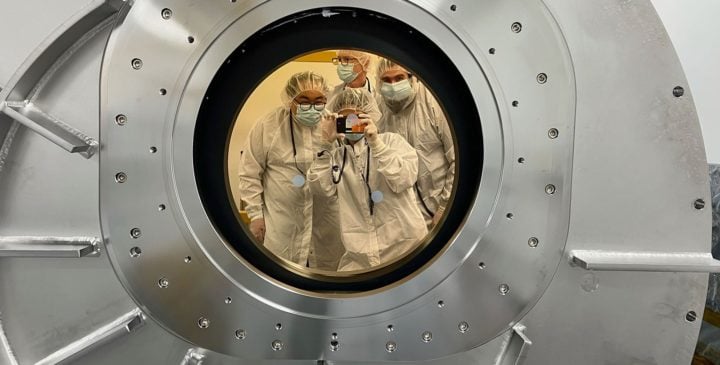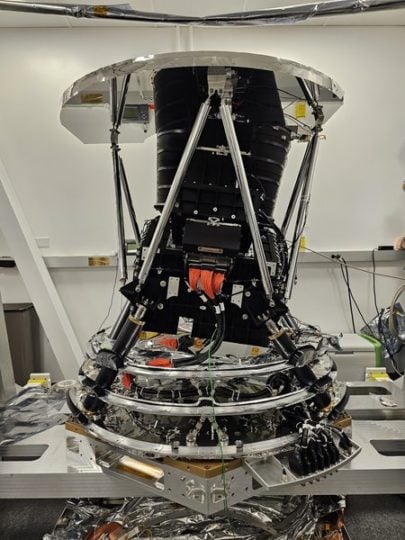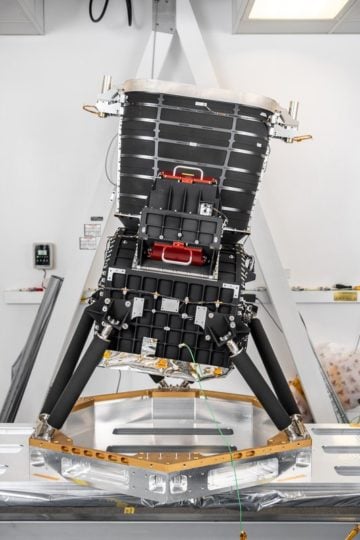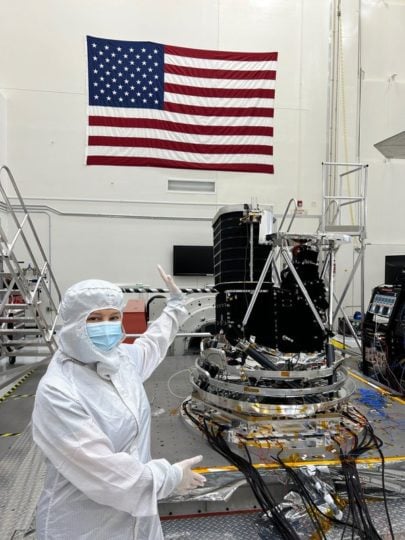NASA’s SPHEREx space telescope has been tucked inside a custom-built chamber on and off for the past two months undergoing tests to prepare it for its two-year mission in space.

SPHEREx team members can be seen in a reflection from the chamber’s gold-coated, sapphire window. The window protects the telescope inside the chamber from the infrared glow of the lab outside. Clockwise from top are Stephen Padin, Phil Korngut, Chi Nguyen, and Howard Hui. Image credit: Caltech
SPHEREx, which stands for Spectro-Photometer for the History of the Universe, Epoch of Reionization and Ices Explorer, is set to launch into orbit around Earth no later than April 2025. It will map the entire sky in infrared wavelengths of light, capturing not only images of hundreds of millions of stars and galaxies but spectra for these objects as well.
Spectra are created by instruments that break apart light into a rainbow of wavelengths, revealing new details about a cosmic object’s composition, distance, and more.

The SPHEREx telescope and detectors will stay cold in space with the help of three “V-groove” radiators, seen here at the bottom of the telescope. Nicknamed the “jewels that keep SPHEREx cool,” these radiators emit thermal energy as infrared radiation out to the sides, and into the cold of space. The radiators are staged such that each one reaches a lower temperature as you move toward the top. The last radiator stage is a plate, located near the top of the telescope, which provides the lowest temperature stage for the long-wavelength detectors. Image credit: NASA/JPL-Caltech
“It’s a small telescope, but it gathers an enormous amount of light thanks to its very wide field of view,” explains Stephen Padin, a research professor of physics at Caltech and member of the SPHEREx team. “This will be the first all-sky near-infrared spectroscopic survey.”
To ready SPHEREx for its journey, scientists and engineers at Caltech and the Jet Propulsion Laboratory (JPL), which Caltech manages for NASA, have been busy testing SPHEREx’s detectors and optics in a basement lab at Caltech’s Cahill Center for Astronomy and Astrophysics.
Because performing these tests requires simulating the extremely cold vacuum of space, the SPHEREx team enlisted colleagues at the Korean Astronomy and Space Science Institute (KASI) to build a specialized chamber for this purpose. The SUV-sized chamber cools the telescope to about minus 350 degrees Fahrenheit (about minus 200 degrees Celsius).

The telescope is tilted to allow SPHEREx to map the entire sky. SPHEREx must carry out its observations without letting sunlight into the thermal system, which means the sun must always be more than 90 degrees off the central axis. If the telescope were pointed straight up, this constraint would leave two holes in the map coverage, located at the north and south ecliptic poles. By tipping the telescope slightly toward the sun, SPHEREx avoids these coverage holes while also preventing sunlight from entering the thermal system. Image credit: NASA/JPL-Caltech
“A series of measurements inside the chamber will test that the telescope is in focus and stays in focus through the shaking of launch,” says Jamie Bock, the mission’s principal investigator, professor of physics at Caltech, and senior research scientist at JPL.
“The chamber will later be used to characterize SPHEREx’s spectrometer, which will capture detailed spectral information for every point on the sky.”
Last year, the custom chamber was lowered into the basement of Cahill with the help of a 30-ton crane, as seen here in this timelapse video. The telescope was then carefully prepared to be placed in the chamber, which included wrapping parts of the telescope in a foil material to block out stray light and keep the telescope cool.
A second timelapse video shows team members loading the telescope into the chamber.
To test whether the telescope is in focus, the team uses a collimator, basically a telescope operating in reverse, to shine an artificial star into the chamber and onto the detectors.
The chamber was designed with a gold-coated sapphire window that allows the team to project the artificial star into the chamber while reflecting heat from the laboratory away from the chamber.
“The lab is glowing at infrared wavelengths,” explains Phil Korngut, a scientific researcher at Caltech and instrument scientist for the SPHEREx team. “We need to keep that nasty thermal background light from getting into the telescope because it would totally swamp the detectors.”

JPL Director Laurie Leshin poses with SPHEREx at JPL. The instrument is mounted to a vibration table for simulating shaking during launch. Image credit: NASA/JPL-Caltech
In between tests at Caltech, the telescope is being shipped to JPL, where a large mechanical shaker is mimicking the vibrations that SPHEREx will experience when it blasts off into space aboard a rocket.
Once SPHEREx passes the tests at Caltech and JPL, it will be shipped to Ball Aerospace in Boulder, Colorado, for integration with the spacecraft starting in March 2024.
The mission’s maps of the sky will showcase stars and galaxies throughout the universe in just over 100 different infrared wavelengths of light. Its images and spectral data will allow astronomers to trace the large-scale structure of the universe to answer fundamental questions about the first moments after the birth of our cosmos 13.8 billion years ago.
SPHEREx will also help answer the mystery of how water arrived on Earth by studying the abundance of water and other ices in regions where stars and planetary systems are forming.
“Our mission is complementary to others like JWST and the future Nancy Grace Roman Space Telescope,” says Chi Nguyen, a postdoctoral scholar research associate at Caltech and member of the SPHEREx team. “They look at objects in detail, whereas we map out the whole sky and look more at global features.”
SPHEREx is managed by JPL for NASA’s Astrophysics Division within the Science Mission Directorate in Washington, D.C. Ball Aerospace will supply the spacecraft. The science analysis of the SPHEREx data will be conducted by a team of scientists located at 10 institutions across the U.S. and in South Korea. Data will be processed and archived at IPAC at Caltech. The SPHEREx data set will be publicly available.
Written by Whitney Clavin
Source: Caltech

